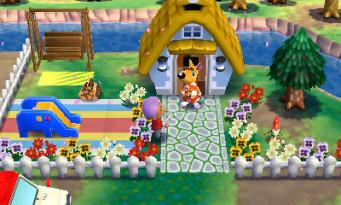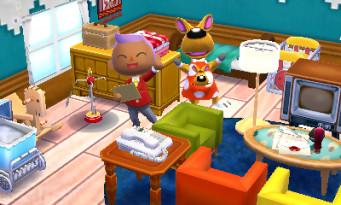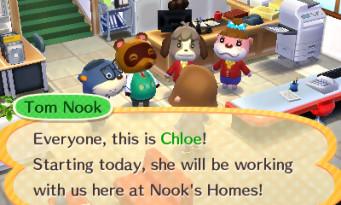 Before getting to the heart of the matter, it is necessary to create your avatar from head to toe, the very one that the Nook Immobilier agency will recruit to take care of the interior decoration of customers. And the requirements of this one are multiple: living in an apartment full of books, having blue everywhere in the house, having plenty of children's toys, being able to relax in a rustic armchair, redoing the whole interior in black and white, falling asleep in the middle of aquariums; this is an example of the imperatives that must be met to satisfy the inhabitants of the city. To make things easier, the majority of them will not hesitate to take some furniture in their suitcases that we will obviously have to take into account in the decoration; which gives a first indication on the procedure to follow. In the same vein, the client never hesitates to express his astonishment or his joy depending on the objects placed in the room. Ah yes, the new furniture and other accessories - all offered for free! - which appear gradually in the catalog often stick to the site being tackled. In short, as much to say that with all these aids, it is difficult to fail in its mission and the worst will never be spat on. The proof ? Even without carrying out any decoration work, the client will find its interior exceptional. Truthful. From there, all the interest of Animal Crossing Happy Home Designer is reduced to crumbs and the constant inconsistency is all the more glaring. For example, we can choose the same land ten times in a row for a new owner, or it will not be possible to put certain objects on a chest of drawers or a table. The pinnacle is still these houses made up of a single room, which is too little for creative minds.
Before getting to the heart of the matter, it is necessary to create your avatar from head to toe, the very one that the Nook Immobilier agency will recruit to take care of the interior decoration of customers. And the requirements of this one are multiple: living in an apartment full of books, having blue everywhere in the house, having plenty of children's toys, being able to relax in a rustic armchair, redoing the whole interior in black and white, falling asleep in the middle of aquariums; this is an example of the imperatives that must be met to satisfy the inhabitants of the city. To make things easier, the majority of them will not hesitate to take some furniture in their suitcases that we will obviously have to take into account in the decoration; which gives a first indication on the procedure to follow. In the same vein, the client never hesitates to express his astonishment or his joy depending on the objects placed in the room. Ah yes, the new furniture and other accessories - all offered for free! - which appear gradually in the catalog often stick to the site being tackled. In short, as much to say that with all these aids, it is difficult to fail in its mission and the worst will never be spat on. The proof ? Even without carrying out any decoration work, the client will find its interior exceptional. Truthful. From there, all the interest of Animal Crossing Happy Home Designer is reduced to crumbs and the constant inconsistency is all the more glaring. For example, we can choose the same land ten times in a row for a new owner, or it will not be possible to put certain objects on a chest of drawers or a table. The pinnacle is still these houses made up of a single room, which is too little for creative minds.From there, all the interest of Animal Crossing Happy Home Designer is reduced to crumbs and the constant inconsistency is all the more glaring.
 Fortunately, Marie is there to offer more interesting challenges as part of the development of the city. Concretely, we will have to take charge of the interior decoration of public establishments such as a school, a concert hall, a café, an office building, a business or a hotel. If the illogicality pointed out above is still palpable - the specifications are often laughable -, we still have a little more space to have fun. Thus, the hospital will include a waiting room, a consultation room and a bedroom, while the restaurant will consist of a main room and a kitchen. Too bad the developers did not go further in their approach, with, for example, expansion projects that would have renewed the experience more effectively. There is a class to add to the local school, but that's it. It should be noted, however, that from a certain stage, there is a way to contact Max to renovate the houses we have taken care of, the clients then giving us carte blanche. Yeah, easy. If we may seem severe with Animal Crossing Happy Home Designer, not everything is to be thrown away, quite the contrary. The interface is exemplary clear, you never struggle to get your hands on this or that object - a search engine is available just in case -, and then the tactile features are perfectly suited to the exercise. Using the stylus, you can move each piece of furniture without breaking your back, knowing that tapping on the screen allows you to change its orientation. Thanks to the directional cross, it is possible to get an overview of the room, but we must admit that the camera is not the most comfortable. We are also surprised that the game does not use the right stick of the New 3DS, when it would undoubtedly have been of great use in this context.
Fortunately, Marie is there to offer more interesting challenges as part of the development of the city. Concretely, we will have to take charge of the interior decoration of public establishments such as a school, a concert hall, a café, an office building, a business or a hotel. If the illogicality pointed out above is still palpable - the specifications are often laughable -, we still have a little more space to have fun. Thus, the hospital will include a waiting room, a consultation room and a bedroom, while the restaurant will consist of a main room and a kitchen. Too bad the developers did not go further in their approach, with, for example, expansion projects that would have renewed the experience more effectively. There is a class to add to the local school, but that's it. It should be noted, however, that from a certain stage, there is a way to contact Max to renovate the houses we have taken care of, the clients then giving us carte blanche. Yeah, easy. If we may seem severe with Animal Crossing Happy Home Designer, not everything is to be thrown away, quite the contrary. The interface is exemplary clear, you never struggle to get your hands on this or that object - a search engine is available just in case -, and then the tactile features are perfectly suited to the exercise. Using the stylus, you can move each piece of furniture without breaking your back, knowing that tapping on the screen allows you to change its orientation. Thanks to the directional cross, it is possible to get an overview of the room, but we must admit that the camera is not the most comfortable. We are also surprised that the game does not use the right stick of the New 3DS, when it would undoubtedly have been of great use in this context.'CAUSE I'M HAPPY !
 Still for the sake of ergonomics, some elements can be moved at the same time: just select them by framing them with the stylus, then move them to the desired location. To duplicate them, you will have to hold R or L while clicking on them. Practice. The other strong point of Animal Crossing Happy Home Designer is the multitude of objects in the catalog. There is something for everyone: a coffee machine, a restaurant dishwasher, a cash register, a daily menu board, a photocopier, a plant shelf, a microphone, a DJ turntable, a violet screen; we could go on like this for a long time. As you will have understood, it is easy to create several different universes, especially when you know that the exterior of houses/buildings, the garden, the walls or the floor can also be customized. By snapping a few game pieces, private home design lessons are accessible. In fact, it is neither more nor less than additional tools (decorate the ceiling, modify the doors and windows, integrate personal patterns) which allow you to refine your creations. Since strictly nothing pushes our avatar to surpass themselves, it is difficult to grasp their importance. Anyway, those who expected to be able to roam freely from one point to another may be greatly disappointed. Indeed, all the infrastructures of the city are concentrated in one and the same district, while it will be necessary to take the car – via a loading screen – to go to customers. The other detail that will undoubtedly surprise purists of the series is the time that is not set on the console clock. At the end of each mission carried out, the assistant Lou will systematically ask the character to write his report - synonymous with saving - before returning quietly to the house.
Still for the sake of ergonomics, some elements can be moved at the same time: just select them by framing them with the stylus, then move them to the desired location. To duplicate them, you will have to hold R or L while clicking on them. Practice. The other strong point of Animal Crossing Happy Home Designer is the multitude of objects in the catalog. There is something for everyone: a coffee machine, a restaurant dishwasher, a cash register, a daily menu board, a photocopier, a plant shelf, a microphone, a DJ turntable, a violet screen; we could go on like this for a long time. As you will have understood, it is easy to create several different universes, especially when you know that the exterior of houses/buildings, the garden, the walls or the floor can also be customized. By snapping a few game pieces, private home design lessons are accessible. In fact, it is neither more nor less than additional tools (decorate the ceiling, modify the doors and windows, integrate personal patterns) which allow you to refine your creations. Since strictly nothing pushes our avatar to surpass themselves, it is difficult to grasp their importance. Anyway, those who expected to be able to roam freely from one point to another may be greatly disappointed. Indeed, all the infrastructures of the city are concentrated in one and the same district, while it will be necessary to take the car – via a loading screen – to go to customers. The other detail that will undoubtedly surprise purists of the series is the time that is not set on the console clock. At the end of each mission carried out, the assistant Lou will systematically ask the character to write his report - synonymous with saving - before returning quietly to the house.As you will have understood, it is easy to create several different universes, especially when you know that the exterior of houses/buildings, the garden, the walls or the floor can also be customized.
 If this approach has the advantage of multiplying short sessions, it also accentuates the repetitive nature of Animal Crossing Happy Home Designer. Assuming things are done correctly, the game can be wrapped up in an afternoon and once the final ceremony is over, you realize that there is not much left to put your teeth into. Oh, you can always turn to amiibo cards (distributed in packs) using the agency's phone. Thanks to them, we can satisfy the desires of the characters they represent, and suddenly keep all the data specific to each of the houses in the pocket. In addition, note that the furniture contained in an amiibo card can be transferred to the console (and vice versa), and that it is quite possible to involve the guest of a card in a house so that he can to visit. Like classic amiibo, amiibo cards cannot be said to be essential. Nintendo will never acknowledge it publicly, but it is obvious that the primary purpose of these pieces of cardboard is to maintain the compulsive buying that eats the brains of fans. Of course, it's impossible to know in advance which amiibo cards you'll get, and then you have to keep in mind that 3DS owners will also have to get an NFC reader which is automatically integrated into the New 3DS. Less expensive, the social options of Animal Crossing Happy Home Designer allow them to publish their houses and public establishments through the Happy Decorators Network (RJD for friends), and submit them to community evaluations. By squatting the PC of the agency, you can also visit the creations of other players, each of them having a reference number or a QR Code to facilitate research. Finally, in addition to screenshots and personal patterns that can be shared on social networks and Miiverse, competitions on very specific themes should be organized regularly in the future. For glory, of course.
If this approach has the advantage of multiplying short sessions, it also accentuates the repetitive nature of Animal Crossing Happy Home Designer. Assuming things are done correctly, the game can be wrapped up in an afternoon and once the final ceremony is over, you realize that there is not much left to put your teeth into. Oh, you can always turn to amiibo cards (distributed in packs) using the agency's phone. Thanks to them, we can satisfy the desires of the characters they represent, and suddenly keep all the data specific to each of the houses in the pocket. In addition, note that the furniture contained in an amiibo card can be transferred to the console (and vice versa), and that it is quite possible to involve the guest of a card in a house so that he can to visit. Like classic amiibo, amiibo cards cannot be said to be essential. Nintendo will never acknowledge it publicly, but it is obvious that the primary purpose of these pieces of cardboard is to maintain the compulsive buying that eats the brains of fans. Of course, it's impossible to know in advance which amiibo cards you'll get, and then you have to keep in mind that 3DS owners will also have to get an NFC reader which is automatically integrated into the New 3DS. Less expensive, the social options of Animal Crossing Happy Home Designer allow them to publish their houses and public establishments through the Happy Decorators Network (RJD for friends), and submit them to community evaluations. By squatting the PC of the agency, you can also visit the creations of other players, each of them having a reference number or a QR Code to facilitate research. Finally, in addition to screenshots and personal patterns that can be shared on social networks and Miiverse, competitions on very specific themes should be organized regularly in the future. For glory, of course.

























